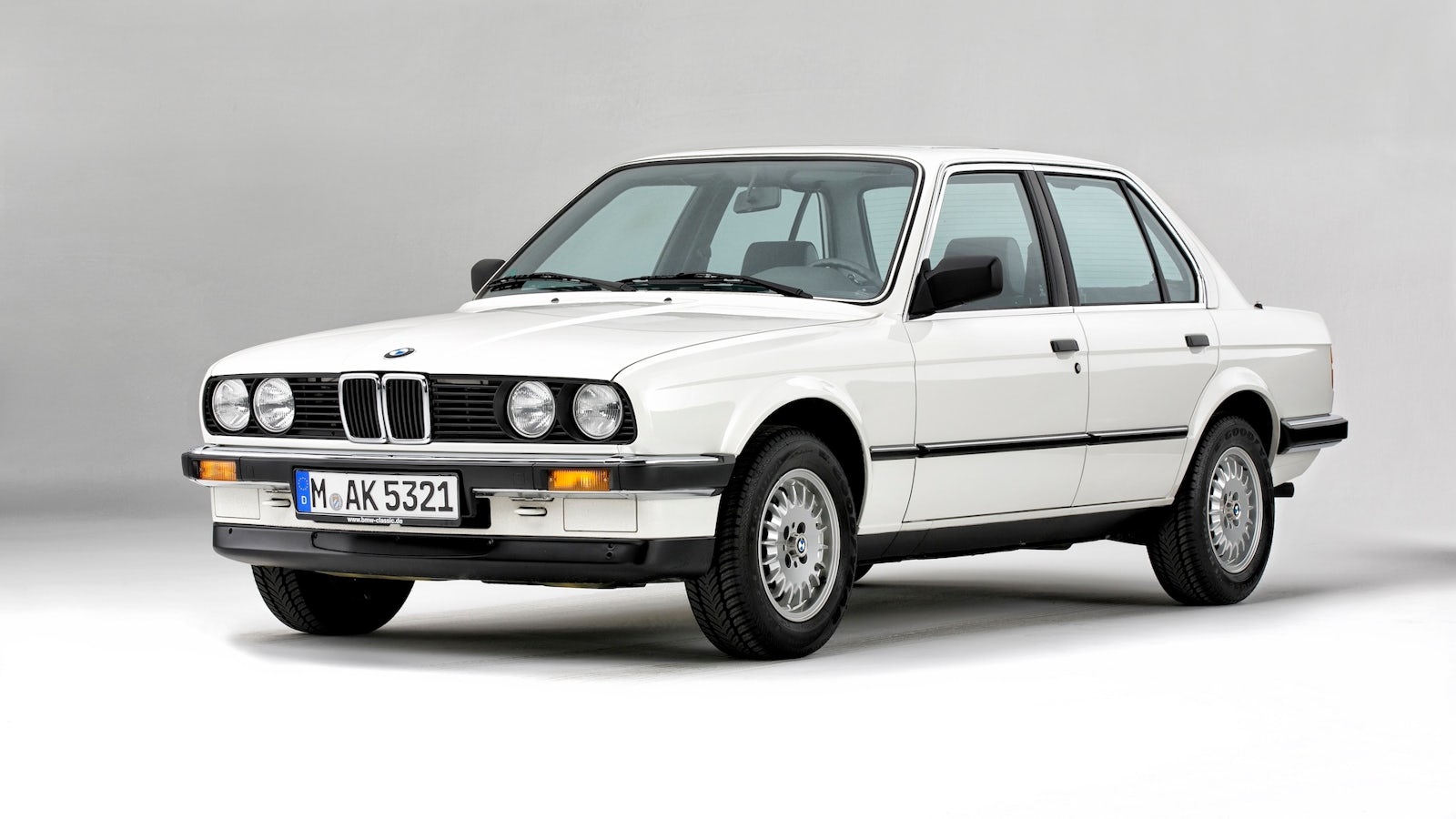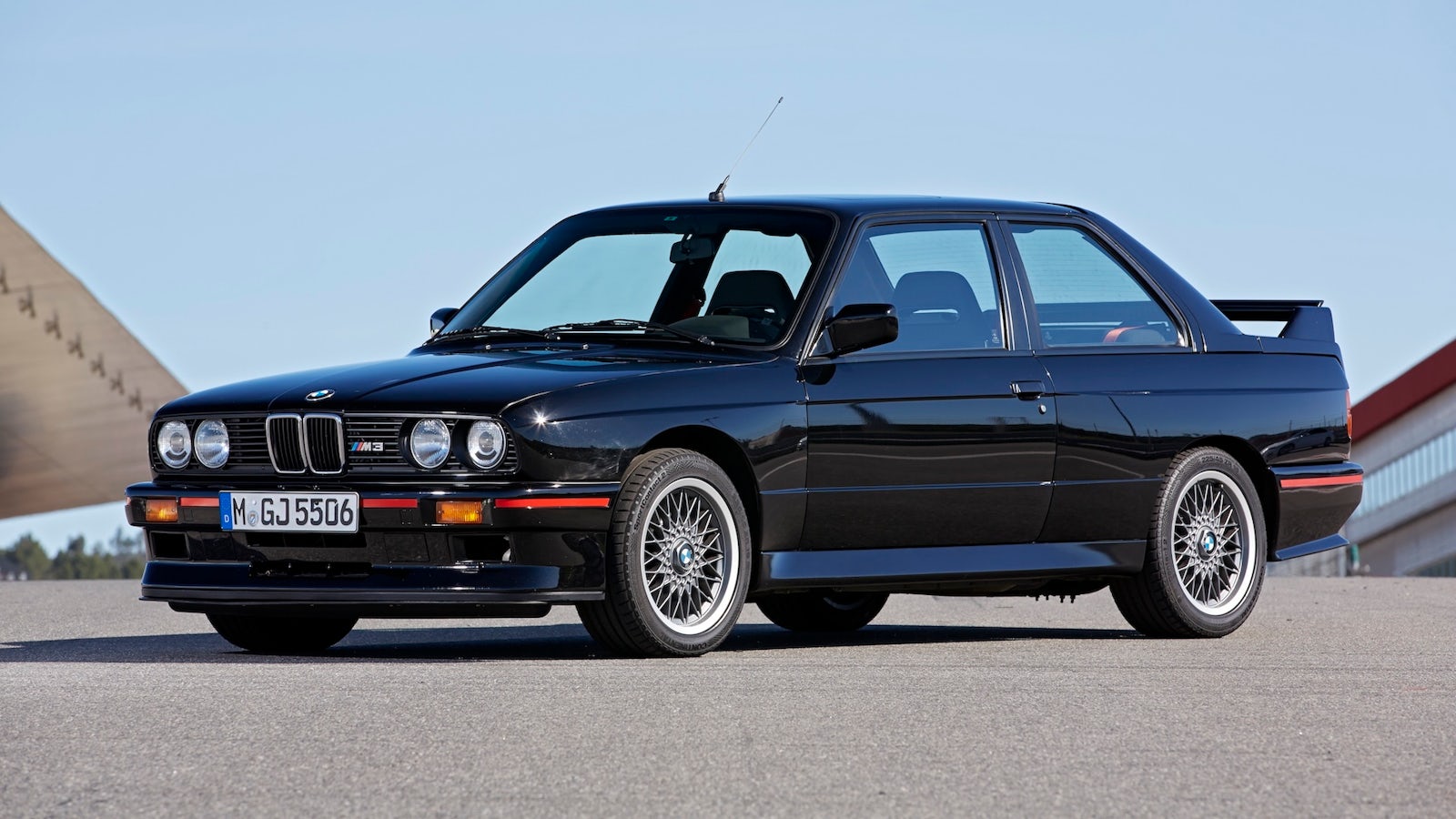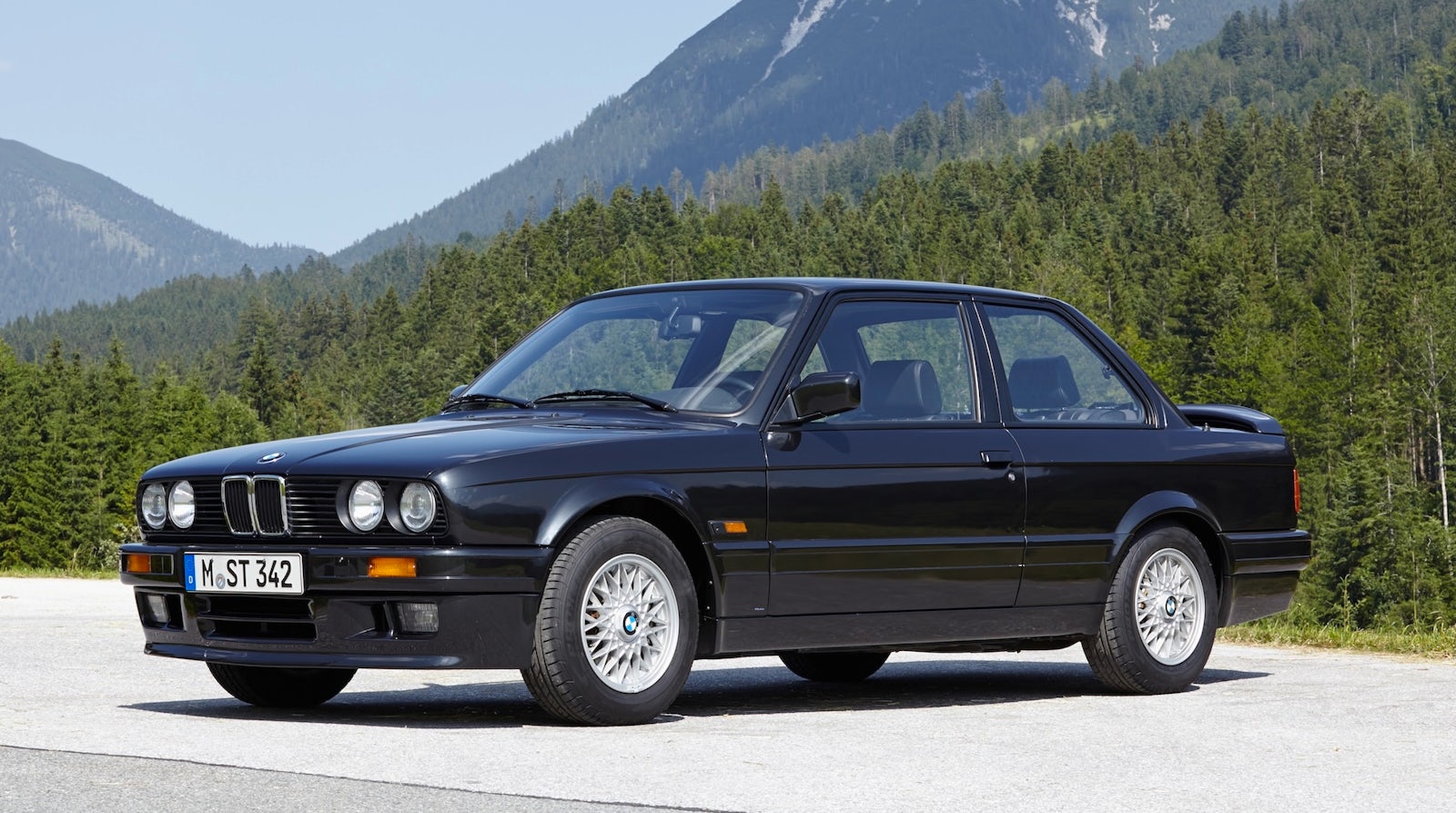BMW 3 Series (E30) Review & Buying Guide (1982-1994)
March 19, 2025 by Mario Christou

- The E30 3 Series was the second generation BMW’s compact saloon
- Almost 2.4 million were produced between 1982 and 1994
- The E30 is 4.3 metres long, just under 1.4 metres wide and weighs between 1080-1200kg
- Power ranges from 75hp in the entry-level 316s to 238hp in the M3 Sport Evo
- The E30 was the first 3 Series to come as a four-door saloon, convertible and it was the first M3 sports car
While the E21 generation introduced the 3 Series model name to the world, it was the E30 generation 3 Series which cemented the 3 Series’ reputation as a stylish, practical and fun compact saloon. Introduced in 1982, the link to its predecessor was clear in its design, but with softer corners and bigger taillights fit for the 1980s. BMW’s venerable ‘sharknose’ was almost gone, with a bluffer front end than the models which had come before – but without losing the sporty silhouette that BMW was known for.
The E30 was the first 3 Series available in a wide mix of body styles, where the E21 was only available as a two-door saloon or ‘Baur’ convertible – a halfway house between a saloon and convertible which was in essence a massive sunroof.

1982 marked the launch of the E30 as a two-door saloon, with the Baur convertible and four-door saloon following shortly after in 1983. Baur convertibles were made by a third-party company called Baur Coachworks. The factory convertible joined the range in 1985, whilst the addition of the Touring estate rounded out the group when it was launched in 1987.
The driving experience varied massively depending on which model you had, but the E30 was seen as a far superior car to drive than most of its alternatives in the 1980s. It may not have looked all that different to its predecessor, but it was a day and night improvement behind the wheel – especially in the big engine sporty models.

All E30s came with front disc brakes and the same basic suspension setup, but the 316 and 318 entry level cars all had fairly lethargic ‘M10’ four-cylinder engines with a single overhead cam. The engines’ roots could be traced back to the early 1960s, and you could feel it. It was the six-cylinder cars that impressed the most at launch, with 2.0 and 2.3-litre ‘M20’ engines that felt much more alive and gave the small BMW some proper sporty credentials.
1986 saw the introduction of what is possibly BMW’s most iconic model ever produced: the E30 M3. Designed as a basis for a new generation of motorsport, the E30 M3 had significant changes compared to the regular car.

It was a proper coupe with dramatic bodywork, a bespoke high-capacity four-cylinder engine with 192hp designated the ‘S14’ and redesigned suspension. The changes turned the M3 into a totally different beast – and a dominant race car in the process. The engine was responsive and rev-happy, but the consensus at the time was that the six-cylinder engines in the regular E30s were still more fun to drive.
Is the BMW E30 3 Series a good car?
Pros:
- Iconic BMW looks
- Compact proportions
- Easy to work on engines
Cons:
- Rust, rust, rust
- Twitchy handling at speed
- Eye-watering prices for sporty models
The BMW is one of the Bavarian marque’s most desirable cars ever produced, and when you say ‘classic BMW’ to someone the E30 is often the car that comes to mind. Part of the charm is that it’s a genuinely usable classic car with reliable engines, practicality on par with a small hatchback and decent performance if you choose the right engine.
Any E30 is very much a heart-over-head decision though, and it’s not as sensible a choice as its successor – the E36. The E30 is the type of car people will stop to compliment, and to tell you about their dad, their aunty or their mate who had one ‘back in the day’.

Even when it was new, the BMW E30 was considered a compact car – and it’s diminutive compared to a modern 3 Series. Yet the E30s small figure is part of what makes it such a good looking car, distilling the classic BMW ‘headlights-in-grille’ design and strong shoulder line into a much friendlier package than its larger 5, 6 and 7-series siblings.
The interior does look seriously dated now. Classic BMW design cues such as the dashboard angled towards the driver are there, but there’s also an array of tiny buttons which aren’t very clearly laid out. Front space is fairly good, but the rear of the E30 is cramped, no matter which model you’re in. As with all BMWs of this vintage the rear seats don’t fold meaning that the already small boot can’t be extended.

Driving the E30 at low speed is a delight; its tiny size, noticeable power steering assistance and soft suspension make it a breeze to drive around town. The gear change is crisp and visibility is excellent thanks to the tall glass and narrow pillars all round.
A major refresh in 1987 updated the E30 with a range of new engines and improvements across the board. Gone were the 1960s-derived units replaced with much smoother and more fuel efficient motors. The pick of the small engines was the 318is, a rev-happy dual overhead cam four-cylinder, while the most desirable model was the 325i. Its 2.5-litre six-cylinder produced 195hp and gave the E30 some real street cred.
Twisty roads are fun in the E30, but they’re certainly not to be taken lightly. The E30’s suspension design hadn’t come along much since the E21, and while it was very grippy with great steering feel, going into a corner with too much speed or lifting your foot off the throttle too quickly would often send an E30 into a spin. It was easy to see why the M3 had such heavily redesigned suspension, but any E30 is a rewarding car to drive if you don’t push it too hard.
What to look out for?
BMWs of the 1980s are very robust vehicles, but their Achilles heel is rust and that should be at the top of your list when looking out for issues on any E30. Sills, wheel arches, the battery tray, the suspension turrets in the engine bay and the rear boot floor are all known for oxidising, as are the A-pillars and sunroof surround, if fitted.
Early cars are much more susceptible to rust than the updated models from 1987 onwards, as the steel in their bodyshells didn’t feature the same level of galvanized protection that the later cars introduced. Early cars are harder to get replacement panels from too, though there are some specialists out there which produce replacement parts in small batches.

Late M-tech cars with factory-fitted bodykits should be checked carefully for rust too, as the big air dams and side skirts often collect dirt and grime which eats away at the sills. If you’re buying a car which is claimed to be a factory ‘M-Tech’ model, be it an early or a late E30, try to get the VIN checked to see if the seller is being truthful.
It might be hard to find records of a car’s factory spec, but there’s a whole aftermarket dedicated to BMW bodykits and a lot of owners dress up base model cars as sport models to make a quick extra buck when it’s time to sell. Early cars featured chrome bumpers which need to be checked too, as re-chroming is an eye-wateringly expensive job and reputable specialists are few and far between these days.
The E30’s interior is fairly solid, but being a product of the 80s, keep an eye out for cigarette burns in the upholstery or carpets as it can be tricky to get ahold of certain replacement fabrics if in need of a repair. The dashboard can crack if it’s been exposed to too much heat, and it can be expensive to get your hands on another one.

Electric-top convertibles are a hassle to repair if there’s a problem with the roof mechanism, so a manual-top is your best bet for simplicity and longevity.
The key thing to look out for mechanically comes on the six-cylinder E30s, and that’s regular maintenance of the timing belt. The belt needs to be changed every 50,000 miles for safety, because if it snaps then you’re almost certainly looking at a replacement engine. Not only are they getting expensive and hard to find, but if you’re interested in keeping a concourse example then an unoriginal engine will devalue your E30. If there’s no history of a belt swap, get it done.
The suspension is fairly simple so just make sure there aren’t any clunks or knocks over dips or potholes, and ideally look out for receipts that show the bushes have been replaced over the car’s lifetime. It’s not an expensive job, but rusty suspension components can be a pain to work on if they need replacing.
Manual cars are far superior to drive than automatics and they’re stronger too. Make sure there are no crunches when going into any gear on a manual, and that an automatic has had a service if the car has ticked over 80,000 miles.
Which is the best one to buy?
The E30 varies so much from model to model that it’s impossible to suggest one that covers all bases, but the 318is might be the pick of the bunch for all-round ability. Its dual-overhead cam four cylinder engine is a delight to use, and being chain-driven it doesn’t have the timing belt stress of the six cylinder cars. It’s less nose-heavy than the six-cylinder models too, and more fun in the corners as a result.
Pre-facelift cars are seen as prettier and more desirable to classic car enthusiasts, with their smaller chrome bumpers and simpler engines giving the E30 a more 1970’s feel. Facelift cars are more usable, with (slightly) less rust issues to worry about and more readily available parts.
A late-model 325i Sport is the most desirable E30 to collectors, and they make for good investments if you plan on keeping it parked in the garage.
Only the earliest E30s are ULEZ/CAZ and road tax exempt, but that means they are semi-realistic daily drivers in town so long as you maintain them properly.
BMW E30 3 Series price guide
Even the leggiest, rustiest and least maintained E30 saloon or convertible will fetch close to £5000 on a second-hand marketplace – but it’ll probably be listed as a ‘project’ and cost you double in repairs and maintenance.
Two-door E30s command higher premiums, especially in 318is or 325i forms. You’ll struggle to find a 318is in good condition for less than £18,000, though you’ll struggle to find one at all because they’re so rare.
The 325i model is a mixed bag as it was much more popular so there are more around, with prices ranging from around £10,000 to £40,000 for manual Sport coupes. The trickiest thing about buying an E30 is to find an original example, because so many have fallen victim to bad modifications over the years.
If you want an example with pristine bodywork, some modified examples have been turned into show cars with gleaming paintwork and interior trims – so they could be worth looking into and re-fitting some original parts instead.
M3s are in a different league altogether, with early high-milers starting close to £70,000 and Sport Evo or special edition examples going well into six-figure sums.
E30 History
- 1982. BMW E30 is introduced as a two-door saloon
- 1983. Four-door saloon and Baur convertibles are added to the range
- 1985. Minor update with better front aerodynamics, 325i and factory convertible models are added to the range
- 1986. E30 M3 is introduced
- 1987. Major update with plastic bumpers, bodywork changes, bigger taillights and the introduction of modern ‘M40’ engines. Touring estate is introduced
- 1990. Last-of-the-line E30s are manufactured as the E36-generation is introduced. Convertible and Touring models stay in production
- 1993. E30 convertible is discontinued in anticipation of E36 convertible
- 1994. E30 Touring is discontinued as E36 Touring is introduced
Car change? Carwow!
Looking for a new set of wheels? With Carwow you can sell your car quickly and for a fair price – as well as find great offers on your next one. Whether you’re looking to buy a car brand new, are after something used or you want to explore car leasing options, Carwow is your one stop shop for new car deals.
Click here to follow us on WhatsApp, where you can keep up-to-date with all the latest news, reviews, advice guides and videos.















